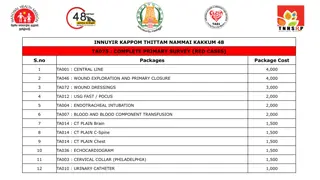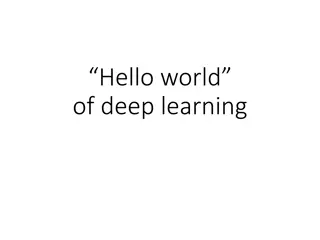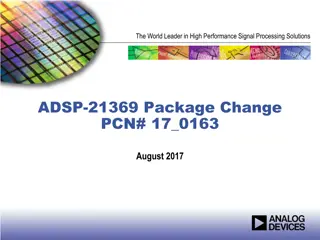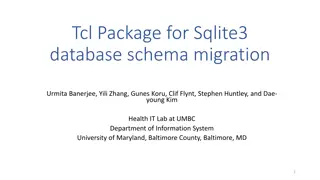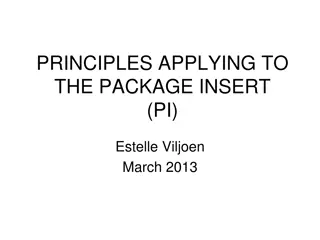Introduction to Torch Deep Learning Package
Torch is a powerful deep learning package developed by Ronan Collobert. It supports various languages and is widely used in universities and research labs for large-scale learning in speech, image, and video applications. Torch enables setting up and training deep networks with configurable hyperparameters, offering a robust implementation of the math behind deep learning algorithms.
Download Presentation

Please find below an Image/Link to download the presentation.
The content on the website is provided AS IS for your information and personal use only. It may not be sold, licensed, or shared on other websites without obtaining consent from the author. Download presentation by click this link. If you encounter any issues during the download, it is possible that the publisher has removed the file from their server.
E N D
Presentation Transcript
Torch Deep Learning Package BETSY V. PAUL ECE 5973 02/27/2018
History.. Ronan Collobert has been the main developer 4 versions(old numbers) Various languages (C,C++, now Lua + C) Includes lots of packages for neural networks, optimization for graphical models, image processing. Used in Universities and major research labs(Google, Facebook, Twitter) Always aimed at large scale learning Speech, Image and Video Applications Large-scale machine learning Applications
Introduction Gives an option to setup deep networks by configuring its hyper parameters and by other useful features. It s a library for LuaJIT popular implementation of LuaJIT programming language. Provides powerful vectorized implementation of math behind the Deep Learning Algorithm. In addition there are various libraries that extend the Torch s functionality for various applications of which are supported by a large community of operations. To some extend it allows you to setup to run and train a deep net. Once configured a Deep net can be called within the routines of your program. In this program we use Torch7
Tensor It s a table in Torch. Equivalent to an array in C. Declared by : r = torch.DoubleTensor(t):resize(3,8) Assignment b/w tensor is simply a copy of its reference. U = t:clone() U:random() creates a 1D tensor V = torch.Tensor(1,2,3,4) the size of this tensor is 4. To get the output of the array v:size(1) = 4 W = torch.one(4) creates a vector of four elements. X[{{2,4}}] creates a sub vector.
Commands in Torch Pow(2) denotes power of 2 To create a matrix M = torch.Tensor{{9,6,3,4}, { 7,2,8,1}} dimension = 2 and rows =2 To get the summary of all sizes we use #. So that the output will be 2x4 To access the elements m[2][3] = 8 or m[{2,3}] torch.range(3,8) creates a tensor of 6 elements from 3 to 8 torch.linspace(3,8,50) -- we ll get a linear range To visualize his we need th>require gnuplot th>gnuplot.plot(torch.linspace(3,8,50)) provides linear plot Th>gnuplot.plot(torch.logspace(3,8,50)) provides logarithmic plot
Continued.. Another way to create a tensor is by using zeros fn Torch.zeros(3,5) Torch.ones(3,2,5) To create a torch eye Torch.eye(3) create an identity matrix of size 3 Gnuplot.hist(torch.randn(1000) More the number of data points the smoother the graph will be. If you want to know what a particular command does do ?torch.randn() We can do casting of sensors here. We can also do various image transformations in Torch
NN forward in Torch NN are performed through Feed Forward Interference (FFI bus). Perceptron Embedded threshold Step Activation Function We need logistic unit How to combine multiple logistic unit to create a neural network Architecture Equations for the same
Neural Network Z= .X
nn.Sequential() sequential module nn. ParallelTable() --parallel module nn. ConcatTable() --shared module nn. SplitTable() --(N) dim Tensor -> Table of N- 1 dim Tensors nn. joinTable(-1) -- Table of N- 1 dim Tensors -> (N) dim Tensor Arbitrary models that can be constructed using lego like containers.
nn Package When training neural nets, autoencoders, linear regressions, convolution of any of these models, we are interested in gradients and loss functions. The nn package provides a large set of transfer functions such as upgradeOutput() compute the output given the input upgradeGradInput() compute the derivative of loss w.r.t input accGradParameters() compute the derivative of the loss function w.r.to weights. The nn package provides a set of common loss functions using upgradeOutput() compute the output given the input upgradeGradInput() compute the derivative of loss w.r.t input
It allows us to do forward and backward propagation using simple commands. nn.Sequential.add() nn.Sequential:forward(input) nn.Criterion():forward(input,target) fwd o/p of the sequential within our loss function nn.Criterion():backard(input,target) used to update the input and to calculate the grad parameters nn.Sequential():zeroAccParameters() nn.Sequential():backward(input,gradCriterion) nn.Sequential():updateParameter(etha)
Training a network Stochastic Gradient Descent(SGD) Mini Batch Gradient Descent (BGD) We an do this by fwd, bwd, updateGradParameters to zero nn.StochasticGradient(net,loss) All we need to do is to ask stochastic gradient to train our network. nn.StochasticGradient():train(dataset)
Jacobian formulation and Hessian ?? ??= [?? ?? ??2, .. ?? ???] ??_ ?? ??1, ??_ ??_= ??????????? ?? ? ? ????? ?? ?????? ???????? ??? ?+1 )Transpose ?. ?? ? ? = a( We use Hessian formulation in torch to avoid this transpose The weight gets updated by = + ??? ??
Lets do an example th> --Sigmoid unit th> require nn; th> n=5 th> k=3 th> lin = nn.linear(n,k) th> -- to see whats inside the linear th> {lin} { 1: { gradBias:DoubleTensor size3 weight: DoubleTensor size 3x5 _type: torchDoubleTensor type of module output: DoubleTensor empty gradInput:DoubleTensor size 3x5 gradWeight:DoubleTensor size 3x5 } } th>lin.weight -0.2607 -0.4467 -0.0150 -0.2823 -0.3858 -0.3918 -0.3297 0.2481 0.4386 -0.3514 -0.3062 -0.1706 -0.1231 -0.2631 0.3477
th>lin.bias 0.4370 -0.2159 -0.2801 [torch.DoubleTensor of size 3] --Now we ve to calculate l1 by th>Theta_1 = torch.cat(lin.bias,lin.weight,2) 0.4370 -0.2607 -0.4467 -0.0150 -0.2823 -0.3859 -0.2159 -0.3918 -0.3297 0.2481 -0.2631 0.3477 -0.2801 0.4386 -0.3514 -0.3062 -0.1706 -0.1231 --And the output will be having 6 columns --we can double check our change in torch by checking th contents by {lin} th>gradTheta_1 = torch.cat(lin.gradBias,lin.gradWeight,2) --the output will be 3x6 zero matrix. If not we need to change it to zero because we need a clean network before we accumulate the parameters to train the network. --Starting a sigmoid th>sig = nn.Sigmoid() th>sig
th>{sig} { } th>require gnuplot; th> z=torch.linspace(-10,10,21) --display the plot here th>gnuplot(z,sig:forward(z)) 1: { gradInput: DoubleTensor empty _type: torchDoubleTensor output: DoubleTensor empty } Th>a1=x th> h_Theta = sig:forward(lin:forward(x)) 0.3613 0.5510 0.2924 --lets try to replace these values Z2 = (1) 1
th> z2 = Theta_1 *torch.cat(torch.ones(1),a1,1) --we need to apply sigmoid to z2. i.e., a2= (z2) th> a2 = z2:clone():apply( ..>function(z) ..> return 1/(1+math.exp(-z)) ..> end th>a2 -0.3613 0.5510 0.2924 --this is same as the number that we obtained above. i.e, our network computes what we ve seen in theory
Backward Pass/ Back Propagation --To define loss function we can use MSE criterion th> loss =nn.MSECriterion() th>{loss} { 1: { gradInput: DoubleTensor empty sizeAverage: true Output } } th> loss.sizeAverage = false
th> y = torch.rand(K) 0.5437 0.4579 0.8444 --to see the size of API fn th> -- forward(input,target) th> E = loss:forward(h_Theta,y) th> E 0.34808619152059 --we can verify the result th>(h_Theta y):pow(2) :sum() 0.34808619152059 --now we want to compute the P.D w.r.to input th> dE_dH = loss:updateGradInput(h_Theta,y) th>dE_dh -0.3727 0.1862 -1.1040 -- we can verify by 2*(h_Theta y) -0.3727 0.0461 -0.2284
--Computing error at the output th>delta_2 = sig:updateGradInput(z2, dE_dh) th>delta_2 -0.0860 0.0461 -0.2284 --Now we ve to calculate the partial derivative of the parameters w.r.to the linear module th>lin:accGradParameters(x, delta_2) --we can see the input in torch by th>{lin} -- to look at the desired partial derivative th>gradTheta_1 = torch.cat(lin.gradBias,lin.gradWeight,2) th>gradTheta_1 -0.0860 -0.0615 -0.0706 -0.1241 -0.0527 0.0461 0.0329 0.0378 0.0664 0.0282 -0.2284 -0.1632 -0.1875 -0.3295 -0.1400 -0.577 0.0309 -0.1533 --we can verify our results by th_delta2: view(-1,1)*torch.cat(torch.ones(1),x,1):view(1,-1) --Now we ve to compute the P.D w.r.to the module th>lin_gradInput = lin:updateGradInput(x,delta_2) -0.0958 0.1339 0.0826 0.0511 0.0773
Now lets train the network --Creating a neural network th>net = nn.Sequential() th>net:add(lin) th>net:add(sig) th>net nn.Sequential{ [input ->(1) -> (2) ->output] (1):nn.Linear(5->3) (2):nn.Sigmoid }
--To perform a forward pass th> pred = net:forward(x) th>pred 0.3613 0.5510 0.2924 th>h_Theta 0.3613 0.5510 0.2924 --To compute the error err = loss:forward(pred,y) th>err 0.34808619152059 th>gradCriterion = loss:backward(pred,y) th>gradCriterion -0.3727 0.1862 -1.1040 --this is equivalent to dE_dh that we calculated earlier
--Before we do backward pass we need to clear the backward bias and weight th>net:get(1) nn.Linear(5->3) --to know whats the P.D of the error w.r.to the weight th>torch.cat(net:get(1).gradBias, net:get(1).gradWeight,2) th>net:zeroGradParameters() th>net:backward(x,gradCriterion) = th>lin_gradInput -0.0958 0.1339 0.0826 0.0511 0.0773 --so we can perform backward step return as i/p gradient to the current nw module th> torch.cat(net:get(1).gradBias, net:get(1).gradWeight,2) -0.0860 -0.0615 -0.0706 -0.1241 -0.0527 -0.0577 0.0461 0.0329 0.0378 0.0664 0.0282 0.0309 -0.2284 -0.1632 -0.1875 -0.3295 -0.1400 -0.1533 --to update the parameters th>etha = 0.01 th>dE_dTheta_1 = torch.cat(net:get(1).gradBias, net:get(1).gradWeight,2); th>Theta_1 etha*dE_dTheta_1
0.4379 -0.2601 0.4460 -0.0138 -0.2817 -0.3854 -0.2164 -0.3922 0.3294 0.2474 -0.2634 0.3474 -0.2778 0.4403 -0.3495 -0.3029 -0.1692 -0.1216 --can be verified by torch functions th>Theta_1_new = torch.cat(lin.Bias, lin.Weight,2) --the output is same as the above table
How to train a System? --X be the Design matrix mxn --Y be the labels/targets/matrix mxk --Here we use SGD For i=1,m do Local pred = net:forward(X[i]) Local err = loss:forward(Y[i]) Net:zeroGradParameters() net:backward(X[i], gradLoss) Net:updateParameters(etha) End
Similarly we can train mini-Batch GD --better in terms of convergence and speeds up, optimization --computational complexity is high for multi-dimensional i/p --steps are same expect that we use a batches for input data Local dataset = {} Function dataset.size return m end for i=1,m do dataset[i] ={X[i],Y[i]} End Local trainer = nn.StochasticGradient(net,Loss) trainer: train(dataset)
Supervised Learning Pre-process the train and test data to facilitate learning Describe a model to solve a classification task Choose a loss function to minimize Defining a sampling procedure (stochastic, mini-batches) and apply one of several optimization technique to train and modify parameters. Estimate the models performance on test data.
Example: Convolutional model for natural images: Define a model with pre- normalization to work on raw RGB images:
Example : Logistic Regression Step 4/5: Define a closure that estimates f(x0 and df/dx stochastically.
Step5/5 Estimate the parameters to train the model stochastically.
Example: Optimize differently Estimate parameters to train the model using LBFGS
Graph Container
Advantages and Disadvantages compares to other Deep Learning Packages (+) Lots of modular pieces that are easy to combine (+) Easy to write your own layer types and run on GPU i.e. Speed (+) Lots of pretrained models, convenient for research (-) You usually write your own training code (Less plug and play) (-) No commercial support (-) Spotty documentation Decent proportion of projects in Torch, but less than Caffe. LuaJIT is not mainstream and does cause integration issues
Applications Torch7 @ Google Deepmind Used exclusively for research and prototyping Supervised and Unsupervised Learning Reinforcement Learning and Sequence Prediction. Torch7 @Facebook Improves parallelism for multi GPU models Improving host-device communications. Computation Kernel speeds (e.g.: convolution in time/frequency domain)




















